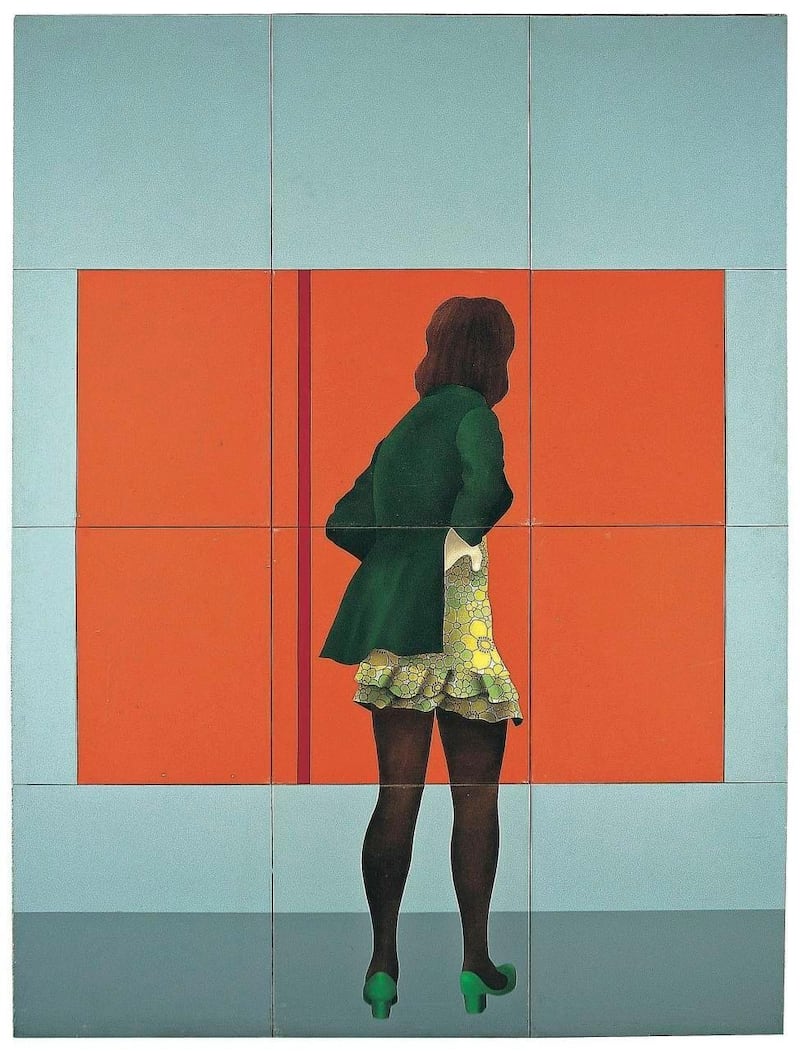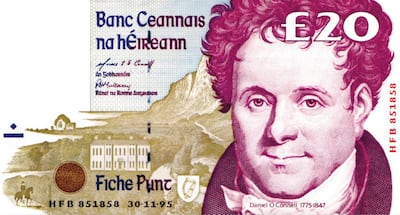From the moment Robert Ballagh opens the door to his studio, there's no mistaking who works there. The front room of the small house in Dublin's north inner city is cluttered with artefacts from the artist's life and work. There are reproductions of Ballagh's playfully perceptive self-portraits and print versions of his distinctive takes on Delacroix and Géricault, a framed copy of the 1916 Proclamation and a North Vietnamese Army pith helmet. The studio space itself is similarly imbued with his personality, a portrait of Samuel Beckett standing beside a slightly chaotic spread of art materials.
Art and literature, history and politics, painterly detail and worldly practicality: all these are trademarks of Ballagh's life as one of Ireland's most distinctive and popular artists. It's a life recalled with brio in A Reluctant Memoir, his newly published autobiography. But, as he discusses his career amidst personal surroundings, there is one poignant absence. Since his wife Betty died unexpectedly in 2011, Ballagh has been missing the woman who not only shared his life but also was his artistic compass.
“She was really good at assessing things,” Ballagh says. “It was really interesting in that when I met her she was 16, a working-class girl from the north inner city, no exposure to art. But through me, she was exposed, and I discovered she had a great eye and could spot a good picture a mile away. And you’re always trying to fool yourself as an artist – ‘this’ll do, that’s grand’. But she’d come in and say, ‘the left eye is wrong’ or something, and she’d be spot-on. I don’t have that any more.”
0 of 5
An affably confident conversationalist, Ballagh is wistful as he remembers Betty. Unsurprisingly, her presence runs throughout his autobiography, even though “she would see a memoir as a totally self-indulgent thing”, hence the reluctance in the title. In fact, there is little solipsism in the book. It is a picaresque personal history, as well as a fascinating insight into Ballagh’s creative process. It’s also a wicked critique of an Irish art scene that has often looked down its nose at Ballagh, despite singular visual works such as his outraged pop art rendition of Goya and his imaginative portrait of politician Noël Browne. Last but not least, it’s an excoriating broadside on the inequities in Irish society.
"Some of it is important to me," he says of the book, "but I think some of it is important in the context of understanding the Ireland of the last 70 years."
Social conscience
Ballagh, who turns 75 next week, opens the book with his bereavement, but even this is refracted through his social conscience. He recounts how Betty died from a heart attack in a Dublin hospital while awaiting a operation on a debilitating bowel condition. He subsequently sued the HSE and two consultants for negligence.
“My reasons were, one, I wanted them to acknowledge that they were negligent, and two, I had hoped by the exposure of this that maybe some other person wouldn’t have to put up with the terrible treatment, though I now realise that the second hope is just nonsense.”
The case was eventually settled, with Ballagh receiving damages and costs. “Cold comfort,” he sighs. “Nothing can fill that hole, that’s the way it is.”
The book isn't all so stark, however. In entertainingly vernacular style, Ballagh retraces his circuitous path to becoming an artist, starting with his childhood in 1950s Dublin. An only child, he grew up in Ballsbridge, happily hanging out with friends from different social and religious backgrounds.
“We all palled together, there didn’t seem to be any disparities of class or anything, which I think would be impossible to experience as a kid now.”
As it happens, Ballagh’s parents came from different backgrounds. His father Bobbie was a Presbyterian, while his mother Nancy was a devout Catholic. Though Bobbie converted to Catholicism – “simply to keep my mother happy, I think” – Ballagh traces his own dissenting instincts to his father’s “quiet contrarian” influence.

“It was only in retrospect I realised there’s that Protestant idea of the individual conscience, which I absorbed almost accidentally,” he says. “Whereas my Catholic half was being told, ‘if you break that rule you go to confession.’ There was no notion of thinking a thing out for yourself and making your own mind up, whether something was morally right or wrong. I’m lucky to have had that.”
I was just messing around the place, waiting for something to turn up
Ballagh's nascent rebellious instincts received a further boost when he discovered the rock'n'roll of Bill Haley, Elvis Presley and Jerry Lee Lewis. "I was just transfixed, I couldn't believe this music," he recalls. He previously had hobbies such as making model airplanes or homemade rockets, "but this was not just an enthusiasm. Rock'n'roll was a passion."
As he went through school at Blackrock College and studied architecture at Bolton Street, music superseded any other artistic inclinations. Playing bass in a showband named The Chessmen, he became a full-time musician after dropping out of Bolton Street. Some of the book’s most enjoyable chapters cover life as a musician playing the dancehalls of Ireland and Britain in the 1960s. Eventually, however, Ballagh tired of touring and quit.
"The thing about my life is that I never really planned anything," Ballagh says. "So I was just messing around the place, waiting for something to turn up. I knew I'd do something, but I didn't really know what. And then I met Micheal Farrell, the artist, who was looking for someone to work with him."
Large murals
For two months in 1967, he worked with Farrell on his large murals for the Bank of Ireland. His life as an artist began.
“I picked up a lot from Micheal, but everything else I had to teach myself,” Ballagh says. “I was bringing skills from making model aeroplanes and stuff as a kid, but without any formal art training. So my stuff inevitably ended up different from people who went through a formal art education, for good or ill.”
Ballagh was drawn to the vibrant colours and bold representational techniques of pop art, making his name with politically-tinged reinterpretations of old masters and large-scale paintings of gallery scenes. Later, he turned his attention closer to home, painting intimate yet witty portrayals of family life in his “No 3” series.
“Up to then I was involved in modernism. And modernism stated clearly that art was about art, nothing else. Formalism, mostly abstract, but always about itself. And I said, ‘I’m going to do a painting that’s about me and my family, because that’s what people are interested in.’
“Also, as someone who is always passionate about literature – I love Joyce, love Beckett, love them all – I wanted to engage with storytelling, which seemed to me so Irish. Yet I was involved in an art practice that sort of denied narrative. That was a real change for me.”
Marked by realistic detail and visual puns, Ballagh's paintings were striking and popular with the public. But he hasn't always found favour with critics or curators. He grumbles at his lack of exposure in galleries such as Irish Museum of Modern Art, whose former director Declan McGonagle once characterised Ballagh as an "illustrator" rather than an artist.
“It’s such a silly in-house art insult to call someone a mere illustrator because the general public don’t know what you’re talking about. Aren’t all artists mere illustrators?”
Ballagh is not just known for his work, of course. Parallel to his artistic vocation, he has been a vocal advocate for political causes, something he traces back to his youth. “I was always strongly concerned about injustice,” he says. “Whether it was in school, somebody being badly treated or bullied, I intuitively spotted things that I felt were wrong.”
His more overt political awakening came when civil rights marchers were attacked by police in Derry in 1968. Meanwhile, having married Betty (with whom he had two children, Rachel and Bruce), he briefly took a job as a draughtsman with “totally Victorian employers who behaved appallingly to the staff”. As a result, he became involved in the union movement.
I do feel that, since its foundation, this State has failed the majority of its citizens
“I learnt on a very practical level that you have to fight for your rights,” Ballagh says. “When you see injustice you can’t just sit idly by, you have to get involved. None of it was ideological, it was practical. It was due to that experience that I got involved in so many things over the years.”
Ballagh discusses his many causes in his memoir, some more contentious than others. He recounts accepting Gerry Adams's invitation to get involved with the inaugural West Belfast Féile in 1988, a decision which drew criticism at the time.
“I knew that if I signed up to help them, and was publicly associated with this, it would be damaging, so I had to think long and hard,” he says. “But here was a group of people in west Belfast, responding to the situation they found themselves in by having an arts festival. It’s a no-brainer, I have to support it.”
Postage stamps
His strong principles aside, Ballagh has also had to earn a living, leading him into unexpected areas. As well as designing many postage stamps, he has designed sets for both highbrow theatre productions and popular shows such as Riverdance. (His latest stage design is for Patrick McCabe's Frank Pig Says Hello in the Dublin Theatre Festival. )

Perhaps most famously, he illustrated banknotes, his portraits of James Joyce and Daniel O’Connell adorning the final series of Irish paper currency. It was a commission that raised eyebrows – “Somebody wrote I was this radical who was also an official state artist,” Ballagh recalls – but he doesn’t see any great contradiction. “I do feel that, since its foundation, this State has failed the majority of its citizens. But that doesn’t translate into any kind of reduction in my pride of Ireland and being Irish.”
He’s more unhappy at the disappearance of the punt, and not just because his designs have disappeared. “Just as a cultural signifier, we’ve lost something. But I also think we’ve suffered economically because of our membership of the euro.”
For all his social concerns and activist zeal, Ballagh doesn’t see himself as a political artist. He prefers Brian O’Doherty’s description of his work as “art made by an intensely political person”. It was art, after all, that helped him in the aftermath of intense bereavement. “I write how shock actually gets you through things. But apart from that, I had this commission to paint James Joyce for UCD. In the months after Betty died, that absorbed an awful lot of my energies, which was very helpful.”
While writing his memoir opened a “Pandora’s box” of memories for Ballagh, both good and bad, he does not intend it as a valedictory statement. The studio is still his home.
“Once I got on this bandwagon, it’s just what I do. Now, I’m fortunate that taking this journey I’ve been involved in lots of allied things, so I never get bored with it. I do get worn out by it, because the longer it goes on, it gets more complicated and time-consuming, particularly the painting. I could paint up a big exhibition in half a year, I now take that time to do one picture. So that’s a bit frustrating. But I can’t imagine doing anything else.”
A Reluctant Memoir is published by Head of Zeus on September 22nd
















